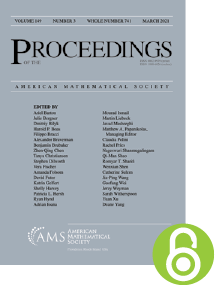Almost disjoint permutation groups
HTML articles powered by AMS MathViewer
- by Fred Galvin PDF
- Proc. Amer. Math. Soc. 124 (1996), 1723-1725 Request permission
Abstract:
A permutation group $G$ on a set $E$ of (infinite) cardinality $\kappa$ is almost disjoint if no element of $G$ except the identity has $\kappa$ fixed points, i.e., if $G$ is an almost disjoint family of subsets of $E\times E$. We show how almost disjoint permutation groups can be constructed from almost disjoint families of sets.References
- James E. Baumgartner, Almost-disjoint sets, the dense set problem and the partition calculus, Ann. Math. Logic 9 (1976), no. 4, 401–439. MR 401472, DOI 10.1016/0003-4843(76)90018-8
- Fred Galvin, Generating countable sets of permutations, J. London Math. Soc. (2) 51 (1995), 230–242.
- W. Sierpiński, Sur une décomposition d’ensembles, Monatsh. Math. Phys. 35 (1928), 239–242.
- Neil H. Williams, Combinatorial set theory, North-Holland, Amsterdam, 1977.
Additional Information
- Fred Galvin
- Affiliation: Department of Mathematics, University of Kansas, Lawrence, Kansas 66045-2142
- Email: galvin@math.ukans.edu
- Received by editor(s): December 20, 1994
- Communicated by: Andreas R. Blass
- © Copyright 1996 American Mathematical Society
- Journal: Proc. Amer. Math. Soc. 124 (1996), 1723-1725
- MSC (1991): Primary 20B07
- DOI: https://doi.org/10.1090/S0002-9939-96-03264-9
- MathSciNet review: 1317037


